
Patpong is an entertainment district in Bangkok's Bang Rak District, Thailand, catering mainly, though not exclusively, to foreign tourists and expatriates. While Patpong is internationally known as a red light district at the heart of Bangkok's sex industry, it is in fact only one of several red-light districts with some catering primarily to Thai men while others, like Patpong, cater primarily to foreigners.

Kanchanaburi is a town municipality in the west of Thailand and part of Kanchanaburi Province. In 2006 it had a population of 31,327. That number was reduced to 25,651 in 2017. The town covers tambons Ban Nuea and Ban Tai and parts of Pak Phraek and Tha Makham, all of Mueang Kanchanaburi District, and parts of tambon Tha Lo of Tha Muang District. Kanchanaburi lies 123 km west of Bangkok.
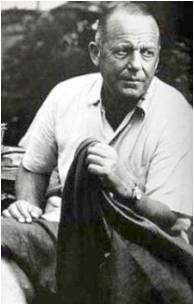
James Harrison Wilson Thompson was an American businessman who helped revitalize the Thai silk industry in the 1950s and 1960s. At the time of his disappearance he was one of the most famous Americans living in Asia. Time magazine claimed he "almost singlehanded(ly) saved Thailand's vital silk industry from extinction".
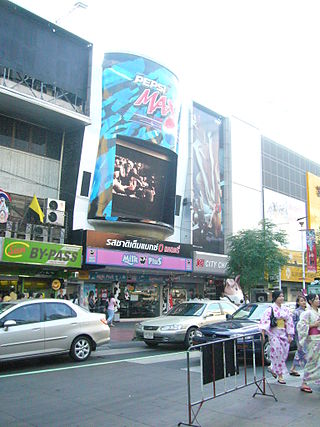
Siam Square is a shopping and entertainment area in the Siam area of Bangkok, Thailand. The square is located at the corner of Phayathai Road and Rama I Road and is owned by Chulalongkorn University, managed by its Property Management Office, known as "Chula Property". It is connected to nearby shopping centers and shopping districts, such as MBK Center, Siam Paragon, and Ratchaprasong shopping district, by a skywalk.

Bangkok University, commonly known as Mo Krung Thep, has operated since 1962, is one of the oldest and largest private, non-profit universities in Thailand. Bangkok University began in the Kluay Nam Thai area of Bangkok. The university expanded its operation to a second and, now, main campus in Rangsit, Pathum Thani to accommodate its rapid growth.

Thai silk is produced from the cocoons of Thai silkworms. Thailand's silkworm farmers cultivate both types of the domesticated silkworms that produce commercial silk: Samia ricini, commonly known as the eri silkworm, which produces matte eri silk, and the Bombyx mori, producer of the better known, glossy mulberry silk. The latter is by far the larger silk producer of the two.

The Bangkok National Museum is the main branch museum of the National Museums in Thailand and also one of the largest museums in Southeast Asia. It features exhibits of Thai art and history. It occupies the former palace of the vice king, set between Thammasat University and the National Theater, facing Sanam Luang.
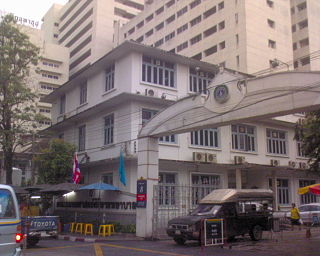
The Siriraj Medical Museum, nicknamed the Museum of Death, is a medical museum in Bangkok, Thailand. Siriraj Medical Museum is open to the public and is a valuable resource for medical professionals and students. This museum consists of seven small medical museums: Siriraj Bimuksthan Museum, Ellis Pathological Museum, Congdon Anatomical Museum, Songkran Niyomsan Forensic Medicine Museum, Parasitological Museum, Touch Museum in Honor of Queen Mother Sirikit, and Sood Sangvichien Prehistoric Museum Laboratory.
The Southeast Asian Ceramics Museum is a history museum in Bangkok University, Pathum Thani, Thailand, displaying Southeast Asian ceramics.
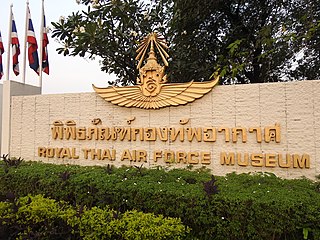
The Royal Thai Air Force Museum is located in Don Mueang District, Bangkok, Thailand. It is located on the Phahonyothin Road just to the south of Wing 6 of the domestic terminal of the Don Mueang Airport. It was served by the Royal Thai Air Force Museum BTS station since 16 December 2020.

Tilleke & Gibbins is a regional law firm in Southeast Asia, with offices in Bangkok, Hanoi, Ho Chi Minh City, Jakarta, Vientiane, Phnom Penh, and Yangon. The firm's core practices are commercial transactions, mergers and acquisitions, dispute resolution, litigation, and intellectual property law.
Bangkok, the capital of Thailand, is one of the world's top tourist destination cities. Each year, approximately 22.7 million international visitors arrive in Bangkok. MasterCard ranked Bangkok as the world's top destination city, with 15.98 million projected visitors in 2013. It topped the MasterCard Global Destinations Cities Index as the most visited city in the world in 2012, 2013, 2016, 2017 and 2018. The city is ranked fourth in cross-border spending, with 14.3 billion dollars projected for 2013, after New York, London and Paris. Euromonitor International ranked Bangkok sixth in its Top City Destinations Ranking for 2011. Bangkok has also been named "World's Best City" by Travel + Leisure magazine's survey of its readers for four consecutive years since 2010.

National Stadium station is a BTS Skytrain station on the Silom Line in Pathum Wan District, Bangkok, Thailand.
James Harrison Wilson Thompson was an American businessman who helped revitalise the Thai silk industry in the 1950s and 1960s. He co-founded the Thai Silk Company in 1948.
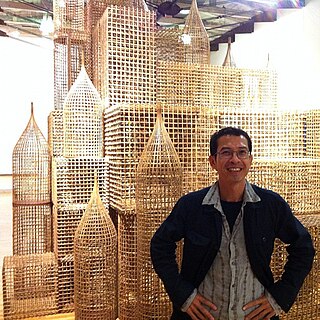
Sopheap Pich is a Cambodian American contemporary artist. His sculptures utilize traditional Cambodian materials, which reflect the history of the nation and the artist's relation to his identity.

The Siam Society Under Royal Patronage was established in 1904 with a mission to promote knowledge of the culture, history, arts, and natural sciences of Thailand as well as those of neighbouring countries. The premises of the Society in Bangkok, Thailand on Asok Montri Road include a library with many rare books and the Kamthieng House Museum in a historic teak house. The Society has a regular programme of lectures, study trips, cultural events, and music performances. The Society publishes two scholarly journals, the Journal of the Siam Society and the Natural History Bulletin of the Siam Society, and several books. The Society is involved in preservation of heritage through the Siamese Heritage Trust. The membership includes people of around 60 nationalities.
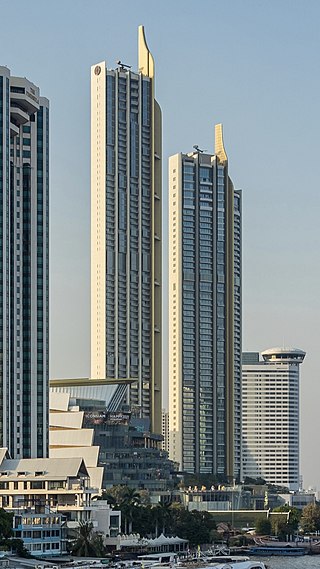
Iconsiam, stylized as ICONSIAM, and ICS is a mixed-use development on the banks of the Chao Phraya River in Bangkok, Thailand. It includes one of the largest shopping malls in Asia, which opened to the public on 9 November 2018, as well as hotels and residences. The ฿54 billion project was jointly developed by Siam Piwat group, a Thai luxury retail developer, MQDC Magnolia Quality Development, and Charoen Pokphand Group. The complex includes the fifth tallest buildings in Thailand: the 52-story Mandarin Oriental Residences and the 70-floor Magnolias Waterfront Residences.

Dvaravati art is a form of artistic work originating from Mon. Dvaravati flourished from the Dvaravati Mon ancient artifacts are in present-day Thailand and Burma, Mon states to the west in southern Myanmar (Burma) and with the Mon state in northern Thailand. Dvaravati experienced political domination by neighbouring peoples on three occasions: in the 10th century, when the Burmese conquered the Mon state of Thaton west of the Tenasserim Yoma; from the 11th to the 13th century, when the Khmer Empire (Cambodia) arose in the east; and finally, in the late 13th century, when Dvaravati was absorbed by the Thai empire.

Ban Khrua is a historic community neighborhood along Bangkok's Khlong Saen Saep from Saphan Hua Chang to Wat Phrayayang. It includes an area of about 14 rai on both banks of the canal. It's divided into three parts: Ban Khrua Nuea ; Ban Khrua Tai in Ratchathewi District; and Ban Khrua Tawan Tok in Pathum Wan District. The main artery is Ban Khrua Nuea in Soi Kasem San 3, Rama I Road, the boundary between Ratchathewi and Pathum Wan Districts.
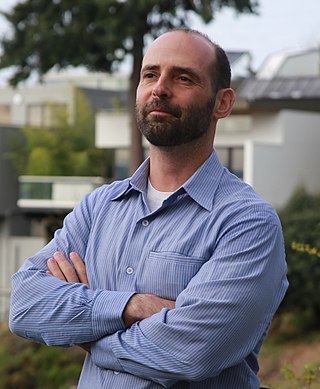
Philip Jablon is an American independent researcher, known for photographing and documenting historic movie palaces and stand-alone movie theaters in Thailand and neighbouring countries through his blog, the Southeast Asia Movie Theater Project.


















